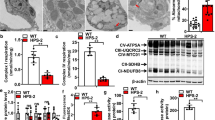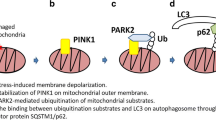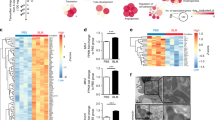Abstract
Rationale
Mitochondrial homeostasis has recently emerged as a focal point in the pathophysiology of idiopathic pulmonary fibrosis (IPF), but conflicting data have been reported regarding its regulation. We speculated that phosphoglycerate mutase family member 5 (PGAM5), a mitochondrial protein at the intersection of multiple cell death and mitochondrial turnover pathways, might be involved in the pathogenesis of IPF.
Methods
PGAM5-deficient mice and human pulmonary epithelial cells were analyzed comparatively with PGAM5-proficient controls in a bleomycin-based model of pulmonary fibrogenesis. Mitochondria were visualized by confocal and transmission electron microscopy. Mitochondrial homeostasis was assessed using JC1 (ΔΨ) and flow cytometry.
Results
PGAM5 plays an important role in pulmonary fibrogenesis. Pgam5−/− mice displayed significantly attenuated lung fibrosis compared to controls. Complementary, in vitro studies demonstrated that PGAM5 impaired mitochondrial integrity on a functional and structural level independently of mtROS-production. On a molecular level, reduced mitophagy caused by PGAM5 deficiency improved mitochondrial homeostasis.
Conclusions
Our study identifies PGAM5 as an important regulator of mitochondrial homeostasis in pulmonary fibrosis. Our data further indicate PGAM5-mediated mitophagy itself as a pivotal gateway event in the mediation of self-sustaining mitochondrial damage and membrane depolarization. Our work hereby highlights the importance of mitochondrial dynamics and identifies a potential therapeutic target that warrants further studies.
Graphical abstract
Toxic agents lead to mitochondrial damage resulting in depolarization of the mitochondrial membrane potential (ΔΨ) which is a gateway event for the initiation of PGAM5-mediated mitophagy. PGAM5-mediated mitophagy in turn leads to a self-perpetuating escalation of ΔΨ depolarization. Loss of the mitophagy-based damage-enhancing loop under PGAM5-deficient conditions breaks this vicious cycle, leading to improved mitochondrial homeostasis.





Similar content being viewed by others
References
King TE Jr, Tooze JA, Schwarz MI, Brown KR, Cherniack RM (2001) Predicting survival in idiopathic pulmonary fibrosis: scoring system and survival model. Am J Respir Crit Care Med 164:1171–1181. https://doi.org/10.1164/ajrccm.164.7.2003140
Aggarwal S, Mannam P, Zhang J (2016) Differential regulation of autophagy and mitophagy in pulmonary diseases. Am J Physiol Lung Cell Mol Physio 311:L433–452. https://doi.org/10.1152/ajplung.00128.2016
Ryter SW, Choi AM (2015) Autophagy in lung disease pathogenesis and therapeutics. Redox Biol 4:215–225. https://doi.org/10.1016/j.redox.2014.12.010
Choi AM, Ryter SW, Levine B (2013) Autophagy in human health and disease. N Engl J Med 368:651–662. https://doi.org/10.1056/NEJMra1205406
Mizumura K et al (2014) Mitophagy-dependent necroptosis contributes to the pathogenesis of COPD. J Clin Investig 124:3987–4003. https://doi.org/10.1172/JCI74985
Larson-Casey JL, Deshane JS, Ryan AJ, Thannickal VJ, Carter AB (2016) Macrophage Akt1 kinase-mediated mitophagy modulates apoptosis resistance and pulmonary fibrosis. Immunity 44:582–596. https://doi.org/10.1016/j.immuni.2016.01.001
Bueno M et al (2015) PINK1 deficiency impairs mitochondrial homeostasis and promotes lung fibrosis. J Clin Investig 125:521–538. https://doi.org/10.1172/JCI74942
Patel AS et al (2015) Epithelial cell mitochondrial dysfunction and PINK1 are induced by transforming growth factor-beta1 in pulmonary fibrosis. PLoS One 10:e0121246. https://doi.org/10.1371/journal.pone.0121246
Lu W et al (2014) Genetic deficiency of the mitochondrial protein PGAM5 causes a Parkinson’s-like movement disorder. Nat Commun 5:4930. https://doi.org/10.1038/ncomms5930
Lu W et al (2016) Mitochondrial protein PGAM5 regulates mitophagic protection against cell necroptosis. PLoS One 11:e0147792. https://doi.org/10.1371/journal.pone.0147792
He GW et al (2017) PGAM5-mediated programmed necrosis of hepatocytes drives acute liver injury. Gut 66:716–723. https://doi.org/10.1136/gutjnl-2015-311247
Holze C et al (2017) Oxeiptosis, a ROS-induced caspase-independent apoptosis-like cell-death pathway. Nat Immunol. 10:10. https://doi.org/10.1038/s41590-017-0013-y
Cloonan SM, Choi AM (2016) Mitochondria in lung disease. J Clin Investig 126:809–820. https://doi.org/10.1172/JCI81113
Park YS, Choi SE, Koh HC (2018) PGAM5 regulates PINK1/Parkin-mediated mitophagy via DRP1 in CCCP-induced mitochondrial dysfunction. Toxicol Lett 284:120–128. https://doi.org/10.1016/j.toxlet.2017.12.004
Hawk MA et al (2018) RIPK1-mediated induction of mitophagy compromises the viability of extracellular-matrix-detached cells. Nat Cell Biol 20:272–284. https://doi.org/10.1038/s41556-018-0034-2
Kim SJ et al (2016) Mitochondrial catalase overexpressed transgenic mice are protected against lung fibrosis in part via preventing alveolar epithelial cell mitochondrial DNA damage. Free Radical Biol Med 101:482–490. https://doi.org/10.1016/j.freeradbiomed.2016.11.007
Gomes LC, Scorrano L (2011) Mitochondrial elongation during autophagy: a stereotypical response to survive in difficult times. Autophagy 7:1251–1253. https://doi.org/10.4161/auto.7.10.16771
Rambold AS, Kostelecky B, Elia N, Lippincott-Schwartz J (2011) Tubular network formation protects mitochondria from autophagosomal degradation during nutrient starvation. Proc Natl Acad Sci USA 108:10190–10195. https://doi.org/10.1073/pnas.1107402108
Moriwaki K et al (2016) The mitochondrial phosphatase PGAM5 is dispensable for necroptosis but promotes inflammasome activation in macrophages. J Immunol 196:407–415. https://doi.org/10.4049/jimmunol.1501662
Matute-Bello G et al (2011) An official American Thoracic Society workshop report: features and measurements of experimental acute lung injury in animals. Am J Respir Cell Mol Biol 44:725–738. https://doi.org/10.1165/rcmb.2009-0210ST
Ashcroft T, Simpson JM, Timbrell V (1988) Simple method of estimating severity of pulmonary fibrosis on a numerical scale. J Clin Pathol 41:467–470
Schindelin J, Arganda-Carreras I, Frise E, Kaynig V, Longair M, Pietzsch T et al (2012) Fiji: an open-source platform for biological-image analysis. Nat Methods 9:676–682
Frezza C, Cipolat S, Scorrano L (2007) Organelle isolation: functional mitochondria from mouse liver, muscle and cultured fibroblasts. Nat Protoc 2:287–295. https://doi.org/10.1038/nprot.2006.478
Acknowledgements
We thank Prof. J. Behrens (Lehrstuhl für Experimentelle Medizin II, Friedrich-Alexander-Universität Erlangen-Nürnberg) for providing the PGAM5 plasmid, Dr. T. Chiriac, Dr. S. Wirtz and Prof. M. von Knebel Doeberitz for supplying material. We thank H. Dorner, G. Förtsch, R. Mehr, S. Rößler, V. Thonn, S. Wallmüller, and A. Wandersee for excellent technical assistance. We thank Dr. M. Neßling for her contribution to the TEM studies.
Funding
This study was supported by funding from the DFG project BE3686/2, research unit FOR2438, SFB1181, SFB796, SPP1656, and clinical research unit KFO257. The Interdisciplinary Center for Clinical Research (IZKF) Erlangen supported I.G. with a laboratory rotation grant and through participation in the Clinician Scientist Program and C.G. with a funding grant (Project A75).
Author information
Authors and Affiliations
Contributions
I.G., M.F.N. and C.B. designed the research. I.G., G.-W.H., C.G., E.-S.P., K.R., R.J.R. and D.M. performed the experiments. I.G., M.F.N. and C.B. analyzed the data and wrote the paper. The authors have declared that no conflict of interest exists.
Corresponding author
Ethics declarations
Conflict of interest
We, the authors, have no conflicting financial interests.
Additional information
Publisher's Note
Springer Nature remains neutral with regard to jurisdictional claims in published maps and institutional affiliations.
Rights and permissions
About this article
Cite this article
Ganzleben, I., He, GW., Günther, C. et al. PGAM5 is a key driver of mitochondrial dysfunction in experimental lung fibrosis. Cell. Mol. Life Sci. 76, 4783–4794 (2019). https://doi.org/10.1007/s00018-019-03133-1
Received:
Accepted:
Published:
Issue Date:
DOI: https://doi.org/10.1007/s00018-019-03133-1




